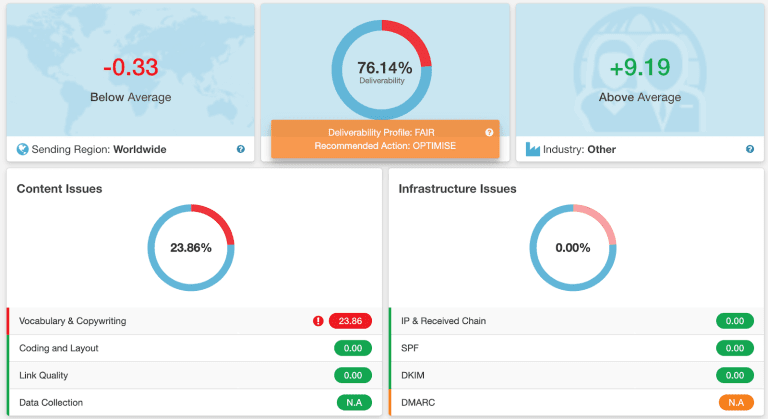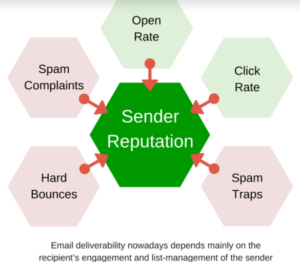Everyone likes a good score, be it sports, video games, or academics. But did you know that your email campaigns also have a score that you can focus on? Both terms like sender score and email reputation are very important and are relevant to email sellers and delivery professionals.
However, for email beginners, it can be difficult to understand what these terms mean and how they affect you. We are here to help - in this article, we will explain what email reputation and sender scores really mean and what each measure is.
Table of Contents
What is the Sender Score?

Using a range starting from 0 to ending with 100, the return path sender score is the email reputation score used to create the sender’s email image of over 60 million inboxes belonging to various ISPs, spam filtering, and security companies. Extracted from non-personal data, internship submission. The sender’s score is usually calculated on a 30-day moving average.
The sender’s score also indicates the total reputation of the sender’s email, but this is not the same thing. Therefore, if the sender has a high sender score, it may indicate that the majority of marketing and transactional emails from the sender will arrive in the inbox. But, if the sender score is very low, your email campaigns are more likely to have high bounce rates, high block rates, and low open rates.
Sender Score Calculation
It is important to understand that the sender’s score will ultimately depend on the data received by the return path. Finally, ISPs decide whether or not to send good emails through their own data sets rather than based on the return path sender scores. Although this score is a good indicator of email sending practice, getting a “high” score does not automatically guarantee that every email campaign will reach your inbox.
The best way to handle email sending is to look at the source and focus on delivery (as opposed to spam folders, the speed at which emails arrive from the sender into the promotional inbox) because the sender’s score is ultimately determined.
How to check your sender score?
Checking the return path sender score is very easy. Follow these steps:
- Go to https://www.senderscore.org/
- Sign up and create an account using your professional email.
- You must receive this confirmation email. Click on CTA to activate your account.
- As soon as you log in, you will be redirected to this page.
- Here you can check the IP address or domain sender score (for example, mailjet.com)
- Searching by domain name will take you to the IP addresses that send mail from this domain, a reference to the volume your email sends to, and finally a page listing your sender score.
These scores can indicate up to 30 days before your search whether this domain is sending a good email or spam.
What is a good sender score?
According to the return path, your sender’s score reveals important data related to:
Complaint Rate - The rate at which users complain that their emails are spam.
Unknown User Rate - The number of invalid users in your subscription list
Active Spam traps - Spam traps play a major role in catching spammers and senders with unsolicited email addresses and poor inventory hygiene practices.
Pristine spam traps are designed to catch unsolicited email accounts and malicious senders. Recycled spam traps are recycling discarded email accounts as spam traps.
For example, domains with a sender score of 90 or higher have a complaint rate of less than 1%, an unknown user rate of 1%, and an average of 0.36% of spam trap hits. In contrast, those with a very low sender score of 10 or less had a complaint rate of 7.4%, an unknown user rate of 7%, and an average spam trap rate of 7.53%.
Having a good sender score and getting emails in your inbox is good for business, but it’s not the end, it’s good for sending emails.
What is the email sending reputation?
Email reputation is a complex metric that includes the various reputations used to identify email delivery methods. Most Important Framework includes:

IP reputation
In 1996, as email became more widespread, spam became a serious problem. To combat this, large Internet service providers (ISPs) that provide email services have begun to use IP reputation to evaluate the quality of emails.
IP reputation indicates how much email users want to receive from a given IP address by measuring bounce, spam, or spam. At the time, there were no very robust methods for authenticating domain addresses, so ISPs would have to create complex IP reputation models that differed from each other, but the problem would be the same task in identifying IP addresses.
Content reputation
Technological advances in the 2000s allowed ISPs to develop a new method of measuring the sender’s email quality through content reputation. Content reputation is based on a set of criteria that determine the quality of the content sender in your email campaign. If certain types of content are clear triggers for ISP content filters (for example, attaching a virus, a string of words requesting bank details, etc.), their content reputation will decline when the sender’s emails are low. Continue to receive or flag open rates. , Blocked and canceled.
Domain reputation
As authentication systems become more robust, ISPs have developed a metric called domain reputation, which measures the quality of email authenticated from a domain. After all, domain and IP can be different. For example, Mailjet customers can use the shared IP we provide and send email via their domain.
Email reputation is a complex metric of many other reputations used to determine email delivery methods. It is played by a constant tagging game between hackers and ISPs who send malicious spam.
Good email sending methods do not end with how you design the content and layout of your emails, they also depend on following strict security protocols that help ISPs identify you as a trusted sender.
Other Email Reputation Indicators
It is also a good idea to invest in other email reputation indicators that are well suited for sending your email. An email marketer in this medium article, for example, points out areas that are ignored by the sender’s score. More than 90 of Google’s postmasters who score and evaluate email sending methods based on Gmail’s sophisticated filtering system have low scores. Therefore, if most of the emails in your list are from Gmail users, then Google Postmaster Tools might be a great choice for you, if not less than other ISPs.
In fact, it is best to understand that ISPs not only measure email reputation differently but may also have different acceptance criteria for different criteria as a whole. For example, the email campaign for Gmail is the main reason for getting great delivery results, with most emails coming into their inbox, but with less stellar results in Outlook.
In any case, ISPs have different filtering systems and often modify them to stay one step above malicious spammers. If all ISP filters work the same way, it will be easier to hack them all. So really, the best way to improve your email delivery is to improve your email delivery methods. Sometimes the best changes are very obvious.
How to improve sender score and email reputation?
As discussed, sender reputation is built on other reputations depending on how you send your email:
IP reputation is measured by the number of people who would like to see an email from this IP address.
Content reputation measures how consistently good your email content is or whether it is spam.
Domain Credit Total authentication of email delivery from your domain, verified by authentication methods.
One thing is to make sure your shipping methods are very good across the board. Below, we have compiled a guide to make sure you are sending emails in the best way possible.
Authenticate your SPF and DKIM
Authenticating your account ensures that only a list of specific IP addresses can send email using your domain. This will prevent spammers from sending fake emails through your domain.
Think of the signature you add to each email campaign as DKIM: DKIM is a powerful test that can be used by the recipient’s ISP to verify that the emails they receive are domain-validated and valid. So if the signatures match, the email goes to the inbox and everything else is the same. If it does not match, it will go (or bounce) to the spam folder.
Create a checklist for your email campaigns
The best practice checklist for all your email campaigns is like the checklist responsible for the sender before you send your email campaigns. The checklist allows them to make sure they have not forgotten anything before sending their email campaigns.
With the strategy of launching authentication systems to improve engagement rates and send email campaigns securely, the last thing marketers can do before sending their email campaigns is to run them by checklist. What to include:
- Good subject line
- A trailing title
- Add UTM tags if they verify that all links are valid and if necessary
- Proofreading
- A good call to action
Check again, remember, there is no cancel button!
Now this checklist can be automated with the tool that runs through email campaigns to make sure they are ready for delivery. But this checklist does not have to be automatic, as the sender can also check it manually.
Create important email campaigns
In fact, the most important thing you can do in your email marketing is to create a strategy that includes processes, workflow, strategy, email campaign database, etc. Creating an email marketing strategy means you have a solid idea of what to do throughout your marketing project.
However, the email strategy is rigid and not bureaucratic. Great email marketing strategy, like any other marketing strategy, allows marketers to experiment throughout the project in line with new trends and sudden opening moments.
The bottom line
Sender score and email reputation are ways to measure sender email sending practices and find places where you can improve your email campaigns and get the results you want, but this is not the end of the story.
Email Health and Efficiency
There are many factors that play an important role in the health of your email reputation and it is more important to look at the overall health of your email strategy than to focus on one indicator.
Ultimately, the way to the inbox is to improve delivery and provide your readers with what they want and need. But, if you are focused on a high score, you can always go into the arcade.




